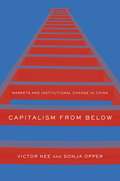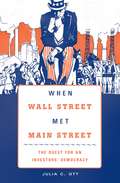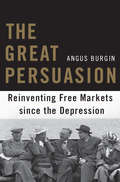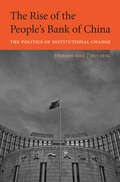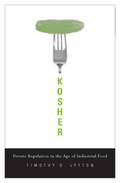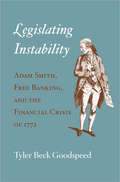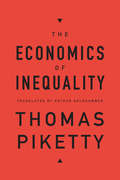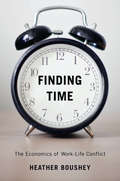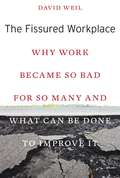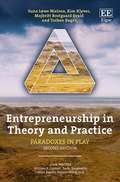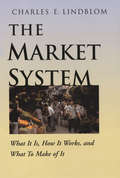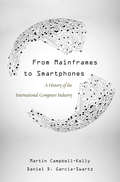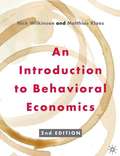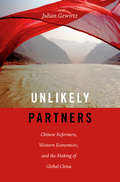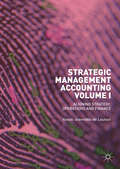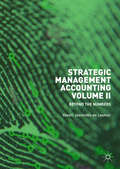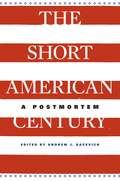- Table View
- List View
Capitalism from Below: Markets And Institutional Change In China
by Victor Nee Sonja OpperOver 630 million Chinese escaped poverty since the 1980s, the largest decrease in poverty in history. Studying 700 manufacturing firms in the Yangzi region, the authors argue that the engine of China’s economic miracle—private enterprise—did not originate at the top but bubbled up from below, overcoming initial obstacles set up by the government.
When Wall Street Met Main Street: The Quest For An Investors' Democracy
by Julia C. OttThe financial crisis of 2008 made Americans keenly aware of the impact Wall Street has on the economic well-being of the nation and its citizenry. Ott shows how the government, corporations, and financial institutions transformed stock investment from an elite to a mass practice at the beginning of the twentieth century.
The Great Persuasion: Reinventing Free Markets since the Depression
by Angus BurginJust as economists struggle today to justify the free market after the global economic crisis, an earlier generation revisited their worldview after the Great Depression. In this intellectual history of that project, Burgin traces the evolution of postwar economic thought in order to reconsider the most basic assumptions of a market-centered world.
The Rise of the People's Bank of China: The Politics Of Institutional Change
by Stephen BellThe People’s Bank of China surpasses the Federal Reserve as the world’s biggest central bank. In the first comprehensive account of the evolution of central banking and monetary policy in reform China, Stephen Bell and Hui Feng show how the PBC’s authority grew from a Leninist party-state that once jealously guarded its control.
The Great Indian Phone Book: How The Cheap Cell Phone Changes Business, Politics, And Daily Life
by Assa DoronOver just a decade in India, the mobile phone was transformed from a rare, unwieldy instrument to a palm-sized staple that even poor fisherman can afford. Assa Doron and Robin Jeffrey investigate the social revolution ignited by what may be the most significant communications device in history and explore the whole ecosystem of cheap mobile phones.
Kosher: Private Regulation In The Age Of Industrial Food
by Timothy D. LyttonIn an era of anxiety about the safety and industrialization of the food supply, kosher food—with $12 billion in sales—is big business. Timothy Lytton tells a story of successful private-sector regulation: how independent certification agencies rescued U.S. kosher supervision from corruption and made it a model of nongovernmental administration.
Legislating Instability: Adam Smith, Free Banking, And The Financial Crisis Of 1772
by Tyler Beck GoodspeedFrom 1716 to 1845 Scottish banks were among the most dynamic and resilient in Europe, effectively absorbing economic shocks that rocked markets in London and on the continent. Tyler Beck Goodspeed explains the paradox that Scotland’s banking system achieved this success without the regulations Adam Smith considered necessary for economic stability.
The Economics of Inequality
by Thomas PikettySuccinct, accessible, and authoritative, Thomas Piketty’s The Economics of Inequality is the ideal place to start for those who want to understand the fundamental issues at the heart of one the most pressing concerns in contemporary economics and politics. This work now appears in English for the first time.
Pitch, Tweet, Engage on the Street: Practicing Global Public Relations and Strategic Communication (PDF)
by Kara AlaimoPitch, Tweet, or Engage on the Street offers a modern guide for how to practice public relations and strategic communication around the globe. Drawing upon interviews with public relations professionals in over 30 countries as well as the author’s own experience as a global public relations practitioner in the United Nations and in U.S. President Barack Obama’s administration, this book explains how to adapt public relations strategies, messages, and tactics for countries and cultures around the globe. The book begins by explaining key cultural differences which require practitioners to adapt their approaches, before discussing how to build and manage a global public relations team and how to practice global public relations on behalf of corporations, non-profit organizations, and governments. Then, the book takes readers on a tour of the world, explaining how to adapt their campaigns for Asia-Pacific, Europe, the Middle East, the Americas, and Sub-Saharan Africa. Along the way, readers are introduced to practitioners around the globe and case studies of particularly successful campaigns – from a public relations "siege" that successfully ended an epidemic of violence in Kenya to the remarkable P.R. strategy adopted by Bordeaux wineries in China that led to a staggering 26,900 percent increase in sales.
Pitch, Tweet, Engage on the Street: Practicing Global Public Relations and Strategic Communication
by Kara AlaimoPitch, Tweet, or Engage on the Street offers a modern guide for how to practice public relations and strategic communication around the globe. Drawing upon interviews with public relations professionals in over 30 countries as well as the author’s own experience as a global public relations practitioner in the United Nations and in U.S. President Barack Obama’s administration, this book explains how to adapt public relations strategies, messages, and tactics for countries and cultures around the globe. The book begins by explaining key cultural differences which require practitioners to adapt their approaches, before discussing how to build and manage a global public relations team and how to practice global public relations on behalf of corporations, non-profit organizations, and governments. Then, the book takes readers on a tour of the world, explaining how to adapt their campaigns for Asia-Pacific, Europe, the Middle East, the Americas, and Sub-Saharan Africa. Along the way, readers are introduced to practitioners around the globe and case studies of particularly successful campaigns – from a public relations "siege" that successfully ended an epidemic of violence in Kenya to the remarkable P.R. strategy adopted by Bordeaux wineries in China that led to a staggering 26,900 percent increase in sales.
Finding Time: The Economics Of Work-life Conflict
by Heather BousheyEmployers demand more of employees’ time while leaving the important things in life—health, family—for workers to take care of on their own time and dime. How can workers get ahead while making sure their families don’t fall behind? Heather Boushey shows in detail that economic efficiency and equity do not have to be enemies.
The Fissured Workplace: Why Work Became So Bad For So Many And What Can Be Done To Improve It
by David WeilIn the twentieth century, large companies employing many workers formed the bedrock of the U.S. economy. Today, on the list of big business's priorities, sustaining the employer-worker relationship ranks far below building a devoted customer base and delivering value to investors. As David Weil's groundbreaking analysis shows, large corporations have shed their role as direct employers of the people responsible for their products, in favor of outsourcing work to small companies that compete fiercely with one another. The result has been declining wages, eroding benefits, inadequate health and safety protections, and ever-widening income inequality. From the perspectives of CEOs and investors, fissuring--splitting off functions that were once managed internally--has been phenomenally successful. Despite giving up direct control to subcontractors and franchises, these large companies have figured out how to maintain the quality of brand-name products and services, without the cost of maintaining an expensive workforce. But from the perspective of workers, this strategy has meant stagnation in wages and benefits and a lower standard of living. Weil proposes ways to modernize regulatory policies so that employers can meet their obligations to workers while allowing companies to keep the beneficial aspects of this business strategy.
Entrepreneurship in Theory and Practice: Paradoxes in Play, Second Edition (PDF)
by Suna Løwe Nielsen Kim Klyver Majbritt Rostgaard Evald Torben BagerAimed primarily at undergraduate students, this highly successful textbook provides the reader with a broad overview of the entrepreneurship phenomenon. It focuses on the emergence, evaluation, and organizing of entrepreneurial opportunities in various organizational contexts. This thoroughly revised second edition brings the reader up to date with the newest trends in the entrepreneurship field and includes four insightful new chapters, covering: * nascent entrepreneurship * design thinking * public entrepreneurship * entrepreneurship policy. New diagrams and figures have been added throughout to clarify key concepts and to clearly illustrate workflow relationships. With real-life international case stories by high profile entrepreneurship scholars, such as William B. Gartner, Saras Sarasvathy, Alain Fayolle, Benson Honig, the book highlights the paradoxes and dilemmas entrepreneurs may encounter on their entrepreneurial journey. Including student involvement, theory, paradoxes, actions, and exercises, all undergraduate students with or without prior entrepreneurship education can enjoy the many benefits, puzzles, and insights the book has to offer.
American Railroads: Decline And Renaissance In The Twentieth Century
by Robert E. GallamoreOverregulated and displaced by barges, trucks, and jet aviation, railroads fell into decline. Their misfortune was measured in lost market share, abandoned track, bankruptcies, and unemployment. Today, rail transportation is reviving. American Railroads tells a riveting story about how this iconic industry managed to turn itself around.
The Market System: What It Is, How It Works, And What To Make Of It (The\institution For Social And Policy St Ser.)
by Charles Edward LindblomIn the wake of the collapse of communism, we hear much about the victory of the 'market system'. Just what is the market system? This clear and accessible book begins by answering this question, then goes on to explain how the market system works and what it can and cannot do. Charles E. Lindblom, writing in nontechnical language for a wide general audience, offers an evenhanded view of the market system. His analysis of the great questions that surround the market system is sometimes unexpected, always illuminating: Is the market system efficient? Is it democratic? Does it despoil the environment? Does it perpetuate inequalities? Does it debase personality and culture? Big choices are yet to be made about the future of the market system, observes Lindblom. He outlines what these choices are and how they will affect not only our economic well-being but also our social and political lives. For market systems organise or coordinate more than just the flow of commodities, he shows. They influence human behaviour in all its dimensions.
From Mainframes to Smartphones: A History Of The International Computer Industry
by Martin Campbell-KellyThis compact history traces the computer industry from 1950s mainframes, through establishment of standards beginning in 1965, to personal computing in the 1980s and the Internet’s explosive growth since 1995. Martin Campbell-Kelly and Daniel Garcia-Swartz describe a steady trend toward miniaturization and explain its consequences.
An Introduction to Behavioral Economics (PDF)
by Nick Wilkinson Matthias KlaesAn Introduction to Behavioral Economics offers a comprehensive, rigorous, and up-to-date introduction to what is one of the most rapidly advancing areas in economics today. It considers the debates in this exciting field through a cross-disciplinary approach that incorporates insights from economics and other social sciences, as well as evolutionary biology and neuroscience. This edition features: · two new chapters, Chapter 2 on methodology and Chapter 4 on beliefs, heuristics and biases · fully revised content, including expanded material on neuroeconomics, rationality, and behavioral game theory · a large number of real-life case studies and examples, as well as review questions
Industrial Eden: A Chinese Capitalist Vision
by Brett SheehanThis study of the evolution of Chinese capitalism chronicles the Song family of North China under five successive authoritarian governments. Brett Sheehan shows both foreign and Chinese influences on private business, which, although closely linked to the state, was neither a handmaiden to authoritarianism nor a natural ally of democracy.
Unlikely Partners: Chinese Reformers, Western Economists, And The Making Of Global China
by Julian GewirtzWith Deng Xiaoping’s blessing, Mao’s successors scoured the globe for fresh ideas to launch domestic prosperity and global economic power. Yet China’s government did not publicize its engagement with Western-style innovations, claiming instead that economic reinvention was the Party’s achievement alone. Julian Gewirtz sets forth the truer story.
Strategic Management Accounting, Volume I: Aligning Strategy, Operations and Finance
by Vassili Joannidès de LautourThis book responds to key issues in strategic management control by studying the interplay between strategy, operations, finance and controls. Grounded in research but written with practitioners and students in mind, it addresses the most up-to-date management control issues in the public sector, forecasting, budgeting and controls in international organisations.
Strategic Management Accounting, Volume I: Aligning Strategy, Operations and Finance
by Vassili Joannidès de LautourThis book responds to key issues in strategic management control by studying the interplay between strategy, operations, finance and controls. Grounded in research but written with practitioners and students in mind, it addresses the most up-to-date management control issues in the public sector, forecasting, budgeting and controls in international organisations.
Strategic Management Accounting, Volume II: Beyond the Numbers
by Vassili Joannidès de LautourThis book responds to key issues in strategic management control beyond the numbers. Grounded in research but written with practitioners and students in mind, this second volume addresses the most up-to-date management control issues in the public sector, forecasting, budgeting and controls in international organisations.
Strategic Management Accounting, Volume II: Beyond the Numbers
by Vassili Joannidès de LautourThis book responds to key issues in strategic management control beyond the numbers. Grounded in research but written with practitioners and students in mind, this second volume addresses the most up-to-date management control issues in the public sector, forecasting, budgeting and controls in international organisations.
The Short American Century: A Postmortem
by Edited by Andrew J. BacevichIn February 1941, Henry Luce announced the arrival of “The American Century.” But that century—extending from World War II to the recent economic collapse—has now ended, victim of strategic miscalculation, military misadventures, and economic decline. Here some of America’s most distinguished historians place the century in historical perspective.
The Land of Too Much: American Abundance And The Paradox Of Poverty
by Monica PrasadMonica Prasad’s powerful demand-side hypothesis addresses three questions: Why does the United States have more poverty than any other developed country? Why did it experience an attack on state intervention in the 1980s, known today as the neoliberal revolution? And why did it recently suffer the greatest economic meltdown in seventy-five years?
